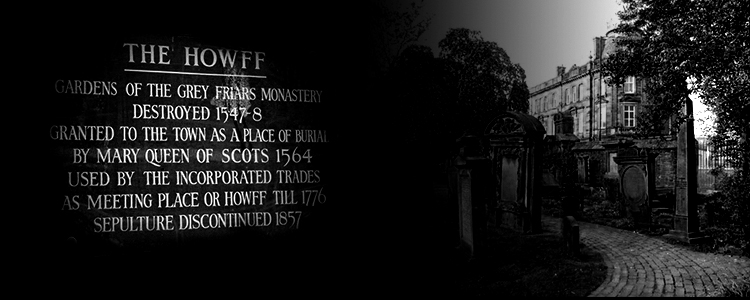The Howff is an iconic landmark in Dundee’s city centre, a calm oasis and a peaceful resting spot to sit in the shade of the well kept trees and shrubs. But as well as housing the graves and crypts of Dundee’s great and the good, the land itself also has a dark history. The land on which the Howff lies was once part of the sprawling Greyfriars Monastery which was laid to ruin during the invasion of Scotland in 1547 when the town of Dundee was stormed by the English under the rule of Henry VIII. During the subsequent Scottish Reformation, the monastery remained in ruins, confiscated by the Crown along with other religious buildings. In 1564 Mary, Queen of Scots granted the land to Dundee for use as a burial ground. At this time, Dundee’s existing graveyards were overcrowded and unsanitary, so Mary, Queen of Scots on the 15th April 1567 granted a charter to the town for the use of the grounds of the Greyfriars monastery, as their new burial ground. This ground became known as the Howff – ‘howff’ meaning meeting place as it was used for meetings by the Dundee Incorporated Trades.
On many of the gravestones you can still see the engravings of symbols and icons related to the trade of the deceased. The graves and tombs of the Howff and those that lay within tell tales of the dark history of Dundee, such as the tomb of Alexander Duncan of Lundie. He was the Provost from 1681 to 1685 and in 1689, in the absence of the current provost, took command when Claverhouse attacked Dundee. He was also the great-grandfather of Admiral Viscount Duncan, who defeated the Dutch in the famous battle of Camperdown in 1797. It is well-documented that the families of many who died could not afford tombstones, so the dead were laid in unmarked graves, leaving the land as a grassy expanse, which not only made for a great meeting place, but also allowed people to air out laundry and graze their animals.
One of the residents of the Howff, Dr David Kinloch, was arrested by the Spanish Inquisition in Spain while travelling Europe. Luckily he cured the inquisitor general of an ailment and was rewarded with freedom, and returned to Dundee. Other well-known folk buried here include James Chalmers, best remembered as the inventor of the adhesive postage stamp, and James Keiller’s mother (James Keiller was the founder of James Keiller and Sons, and his family are credited as the inventors of marmalade). Several other well known Dundee families have their ancestors buried here including Lyells, Forresters, Muirs and Guthries.
Due to overcrowding, a “new” Howff was built a short walk away from the original site, but was subsequently built over and replaced by Bell Street car park and Abertay library. At the back of the library, it is possible to see a few of the headstones incorporated into the wall. It’s definitely worth thinking about the next time you park your car there or visit the library!
[su_box title=”Burial Grounds of Dundee in Pictures”]
See pictures of the Howff and the ‘new’ Howff in our book – pre order now[/su_box]
The records of some 80,000 burials at the Howff over 300 years show there were also many infants laid to rest at the Howff. Many of them died from diseases practically unknown today with many of the records showing ‘teething’ as the cause of death. Babies often died during teething periods due to fever, or increased rates of infection while teething due to the practice of cutting the gums open to allow teeth to grow through. Many of the deaths were also caused by diseases such as whooping cough, small pox or measles which are now prevented by vaccines. Water in the head was often recorded as cause of infant death, which is an abnormal build-up of cerebrospinal fluid in the cavities of the brain.
Reading the lists, generously provided online by Friends of Dundee City Archives at www.fdca.org.uk makes for very grim reading but in our opinion, is really worth a visit for a really in-depth insight into not only the volume of people buried there, but the variety of ways in which the deceased met their demise.
Several causes of death highlight the tragedies that struck some families. Several entries tell of very young children dying because of their clothes catching fire, which would have been a more common accident in the 18th and 19th century due to the use of fires and candles in a time before electricity. One 27 month old infant was killed by a cart passing over them. These tragic accidents must have devastated families who had likely already lost family or friends to the many diseases that plagued our town in those times, such as the sad tale of William Crookshanks, buried in 1835 at age 3 after falling into a well and drowning or the poor, unnamed son of Thomas Davidson Henderson, who perished after only half a day.
We will leave you on a slightly less morbid note, as there are some buried in the Howff who reached a ripe old age for the times in which they lived. Isabella Abbot was buried in 1850 having died of old age at 93, her last address being listed as Lochee. John Adam, a weaver originally from Kirriemuir also died of old age at the grand age of 90. Even with people dying of consumption, scarlet fever, cholera and dropsy, some hardy critters managed to escape the line of fire and were able to live out long lives, albeit in harsh times.
– DD Tours operates walking tours in Dundee city, covering dark local history such as wars, battles, murders, diseases, riots, disasters and executions. Walk with us for an unforgettable storytelling experience.
***

